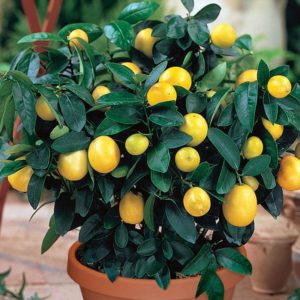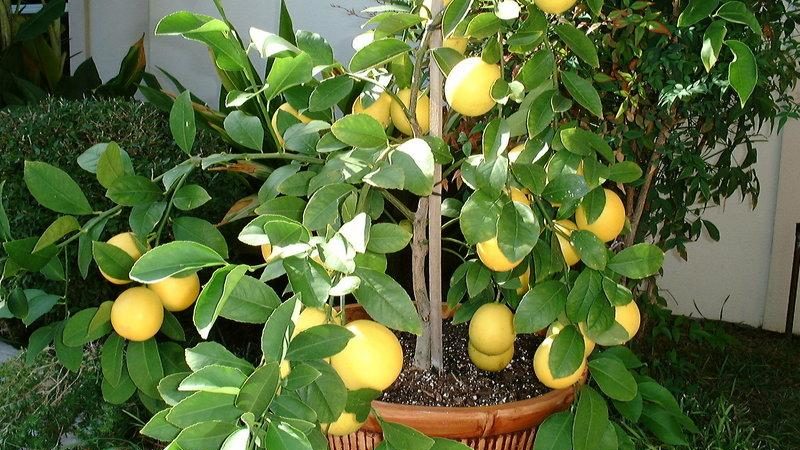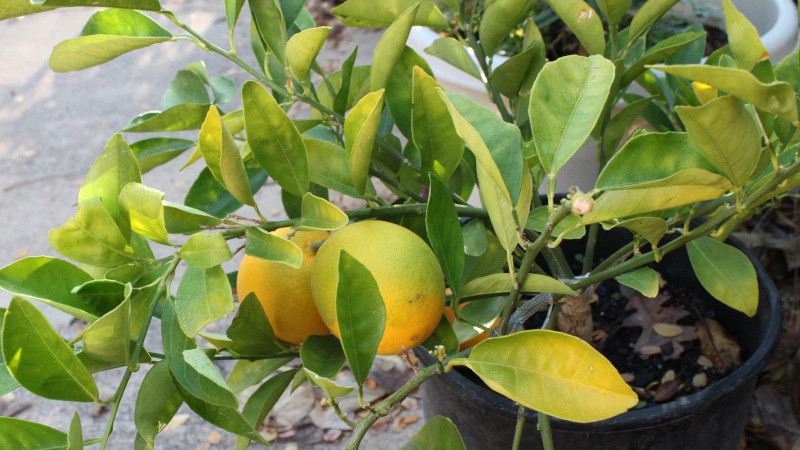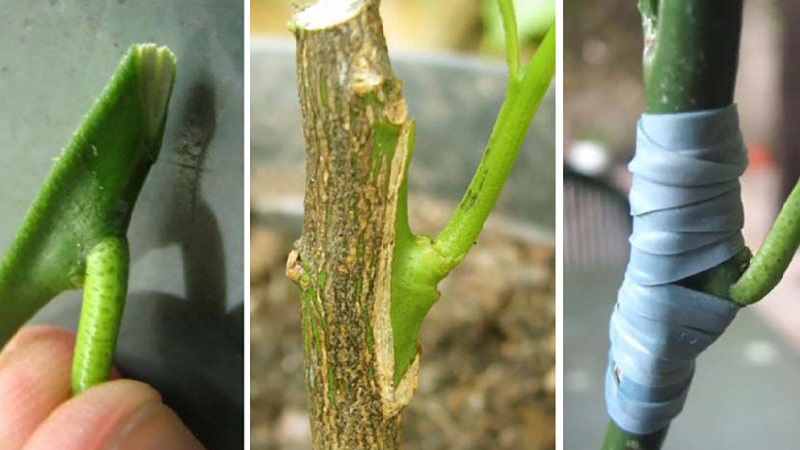Orange variety of Meyer's lemon: description, advantages and disadvantages, cultivation features
Lemons are grown not only outdoors and in the greenhouse - they are cultivated as indoor plants. Citrus trees easily take root in pots, and with proper care they bloom and bear fruit. To make a room lemon look beautiful at home and give large yields of delicious fruits, it is better to plant dwarf varieties. Meyer's lemon is ideal for this. It is distinguished by its short stature and unusual orange fruits.
The content of the article
general description

Meyer's lemon is a natural hybrid of pomelo, mandarin and citron... This is what makes it especially interesting for citrus lovers.
The plant is famous for its unusual color and taste of fruits, suitable for cultivation at home, despite the exactingness of care.
Origin story
There are 2 versions of the origin of Meyer's lemon... According to one of them, this is the result of a natural crossing of mandarin, citron and pomelo, according to the other, it was obtained as a result of the long work of Chinese breeders from Cantonese lemon.
Lemon with orange fruits has long been cultivated in China as a tub crop. In 1908, the plant was brought to America by the businessman and botanist Frank Meyer, after whom it got its name. Citrus quickly gained popularity among Americans and began to be actively cultivated in California nurseries. In 1930, the culture was brought to the USSR in an improved form.
Interesting! It is popularly called the Chinese dwarf, Peking and Chinese lemon. In Russia, the name "Abkhaz citrus" is found.
In the 40s, when Meyer's lemon was grown everywhere, an unpleasant feature was found in it: many copies were infected with the dangerous tristeza virus. Moreover, on the hybrid itself, the consequences and symptoms of the disease did not appear in any way. The infection spread to other citrus fruits and resulted in the death of a huge number of lemons around the world.
Because of this, the bulk of Meyer's lemons were destroyed. Already in 1950, a virus-free hybrid was developed. In 1970, the improved Chinese dwarf was allowed to grow again.
The problem of tristeza infection is still relevant. This is due to the fact that not all of Meyer's offspring infected with the carrier of the virus were destroyed. There is a risk of buying not an improved version with high immunity, but an old clone that will infect other citrus fruits.
Specifications

The Chinese dwarf is one of the best options for home growing. This is due not only to its miniature size, but also to other features. The main parameters of the plant:
- Crown. At home, the height of the tree does not exceed 1.5 m. The culture tends to grow a large number of shoots even without formation. Unlike many other citrus fruits, Meyer's lemon tends to form not a stem, but a bush. The branches are strong and not thick. A small number of small thorns are formed on them.
- Leaves. The tree forms many tough and dense dark green leaves with a leathery texture, which results in a dense crown. The leaves themselves are small, egg-shaped with a pointed end and jagged edges. The leaf plates differ from other citrus fruits by smell: it is citrus, but not lemon.In winter, active leaf fall is often observed, up to the complete loss of leaves.
- Bloom. There are up to 4 of them per season, at this time a delicate aroma emanates from the plants. The first small inflorescences or single buds often appear as early as 2 years after planting. Many flowers are formed even on the shoots of the current year. The flowers are small, white or cream inside, outside with purple, lilac or pink stains.
- Fruit. Miniature, rounded, average weight - 80–100 g. The rind is thin, smooth and shiny, without tuberosity, orange tint. The yellow or orange pulp consists of 6-10 slices, with up to 10 seeds per fruit. The taste is sweet and sour juicy with light bitter notes. The fruit contains up to 51% juice of the total mass, which contains 3-4% less citric acid and 10-12% more fructose than ordinary lemons.
- Fruiting. The plant is early maturing: the fruits ripen within 8 months after the formation of buds. The first crop is harvested 4-5 years after planting.
The transportability of fruits is low: due to their thin skin, they wrinkle and deteriorate during transportation.
See what Meyer's lemon looks like in the photo.

Resistance to negative factors
The characteristics of caring for it directly depend on the degree of resistance of the hybrid to various factors:
- Meyer's lemon is characterized by increased cold resistance. It can withstand short-term cold snaps down to -10 ° C, which allows it to be grown in Abkhazia and the Caucasus (the northernmost countries where citrus fruits are cultivated in the open field).
- The plant is light-requiring. If other lemons are not recommended to be grown on the southern windowsill, then for the Chinese dwarf it is here that optimal conditions are observed.
- The culture is triste-resistant. At the same time, old clones carry the virus, but they themselves do not suffer from its influence.
- In a cold room in winter, the development of the plant stops before warming, but with optimal lighting and temperature, the lemon is able to do without the dormant stage.
- The hybrid is picky about watering and air humidity, if the conditions of care are violated, it begins to hurt and dies.
- It has no resistance to other diseases, it is often affected by pests.
Although Meyer's citrus is able to adapt to different weather conditions, it is quite whimsical. So that the plant does not hurt and feels comfortable, you will have to pay enough attention to it.
Advantages and disadvantages
The hybrid has many advantages:
- unusual color, taste and aroma of fruits;
- early maturity;
- the ability to adapt to different climatic conditions;
- abundant flowering, the formation of a large number of shoots;
- high productivity;
- does not require shading and winter rest;
- takes root easily;
- does not have tristeza.
There are both hybrids and disadvantages:
- lack of immunity to fungal diseases;
- low transportability;
- exactingness to care;
- impossibility growing from a bone;
- the need for the mandatory formation and removal of excess inflorescences;
- the risk of buying an "old clone" - a carrier of a virus dangerous to other citrus fruits.
Growing technology
Growing a lemon tree with orange fruits at home is within the power of even novice gardeners. The plant requires attention and regular care, but you won't have to spend a lot of time on it.
Optimal conditions
In order for citrus not to get sick and to develop correctly, it is important to provide it with optimal conditions for growth:
- Temperature. During the growing season, it is maintained within + 18 ... + 25 ° C. The optimal indicator is + 20 ° C. In winter, the plant is moved to a room with a temperature of + 5 ... + 12 ° C.
- Humidity. This figure should not be lower than 70%. In summer, in the morning and in the evening, the leaves are sprayed with warm, settled water. In winter, use a humidifier or place containers of water near the lemon.
- Lighting. The culture requires 12 hours of daylight hours, it is better to put it on the southern windowsill. When the sun is most active, the window is shaded with a translucent curtain.If the lemon is dormant in winter, no additional lighting is necessary.
If it is not possible to provide citrus with a lower temperature in winter, it is grown as usual. In this case, it will not be at rest. Then you will have to use phytolamps standing at a distance of 15–20 cm from the pot.
Important! Meyer's lemon does not tolerate sudden changes in temperature. Before taking it outside, bringing it into the house or lowering the temperature for the winter, the tree must be tempered.
Boarding and transfer rules
For planting and transplanting a plant, it is important to choose the right soil. Lemons are not recommended to be planted in peat soil. Therefore, it is better to buy either special earth for citrus fruits, or prepare it yourself.
For young plants, the soil mixture should look like this:
- turf - 2 parts;
- humus - 1 part;
- sand - 1 part;
- sheet land - 1 part.
All ingredients are mixed. Add 1 tbsp to a bucket of soil. ash and 1 matchbox of superphosphate.
For adult plants, use a heavier soil:
- turf - 3 parts;
- sheet land - 1 part;
- sand - 1 part;
- humus - 1 part;
- clay - 1 part.
The resulting soil is suitable for rooting cuttings and seedlings. When planting a lemon, do not deepen the root collar. This mistake becomes the cause of many diseases.
Plants purchased at the store must be transplanted into a new pot. For the first pick (even if the plant is already adult), use the first version of the soil.
Lemons are transplanted annually before the first fruiting. Then the frequency of procedures is reduced to 1 time in 2-3 years. Large adult plants are not transplanted - the top of the soil is taken from the pots, replacing it with a new nutrient mixture.
In addition to land, drainage will be needed. It eliminates the risk of moisture stagnation, which is harmful to citrus fruits. The thickness of the drainage layer in the pot must be at least 1 cm.
Important! The soil, drainage and container must be disinfected before use with a high temperature or a dark pink solution of potassium permanganate.
The containers for each new transplant are taken 5-6 cm larger than the previous one. The pots shouldn't be much larger than the plants.
Further care
Correct and regular care is the key to health and rapid cultural growth. It depends on whether the plant will produce a crop.
Home care for Meyer's lemon:
- Watering. In summer, lemon is moistened once a day, in the morning or in the evening, when the sun is inactive. Moreover, irrigation should not be abundant. Some growers pour water into a tray under the pot. In winter, the plant is watered more often 2 times a week.
- Top dressing. In spring, summer and autumn, lemon is fertilized once every 2 weeks. They use special compositions for citrus fruits, chicken droppings, rotted manure, infusion of vegetable peelings, fish broth, coffee and tea.
- Formation. When the central trunk reaches 20 cm, pinch the growth point. The branches of the first order are shortened to 25 cm. The shoots of the subsequent orders are pinched when they reach 15–20 cm.
- Pruning. Dry, weak and damaged shoots are removed from the tree annually.
- Bloom. If this happens already in the second year, all inflorescences are cut off so that the tree does not start to hurt. Further, the procedure is carried out only if there are too many flowers: this will increase the yield.
- Cleaning. Every week, the leaves are wiped with a damp cloth. Once a month, the lemon is washed under the shower.
Possible problems

Even if you take care of lemon correctly, novice gardeners have a risk of facing a number of problems:
- The leaves have become faded. This indicates that the plant lacks light or nutrients. To solve the problem, increase the amount of dressings and use additional lighting.
- A cobweb on the seamy side of the leaf plate, drying out of greenery and shoots - symptoms of spider mite damage.To save the plant, it is washed under the shower and sprayed with soapy water.
- Withering and falling leaves. In winter, this reaction is normal for a plant. If the problem occurs during the growing season, this indicates insufficient watering or the use of cold water.
- Leaves wither and crumble despite sufficient watering with warm water. In this case, it is important to check the roots. If there are traces of rot on them, then the plant is affected by a fungus. The diseased parts are removed. The cut sites are treated with a dark pink solution of potassium permanganate, the tree is transplanted into disinfected soil.
Harvesting and application of the crop
The crop is harvested when the fruits turn orange. The darker the fruit, the sweeter it will be. So, depending on the time of collection, they regulate the taste of lemon fruits.
The pulp is added to salads and desserts.
Reproduction

Lemon hybrids multiply only in a vegetative way, this also applies to Meyer. From the seeds collected from its fruits, a wild will turn out that does not inherit parental characteristics.
Most often, the culture is propagated by cuttings. To do this, choose a healthy one-year-old branch and cut it so that 2-3 healthy buds remain on the cut. The cutting is treated with a solution of potassium permanganate and "Kornevin".
Advice! Reviews of citrus fruit lovers suggest that the most hardy hybrid lemons are obtained if they inoculate wild wild on the stock.
The planting material is rooted in water or soil. When shoots begin to appear from the buds, the seedling dive into a ceramic container with drainage holes.
Conclusion
Meyer's lemon is one of the most unusual home-grown citrus fruits. Its fruits have an unusual taste and color, the tree itself is notable for its short stature, resistance to cold snaps and heat, and rapid ejection of shoots.
Despite its endurance, Meyer's citrus is picky about care. If you violate the rules of watering, insufficient nutrient soil or a lack of light, the tree begins to ache.